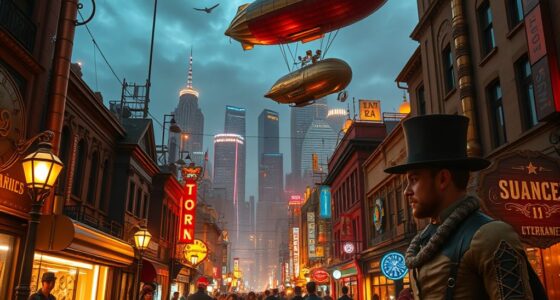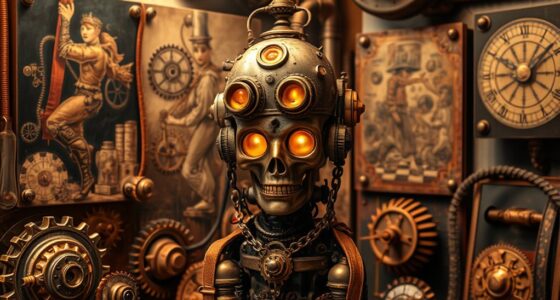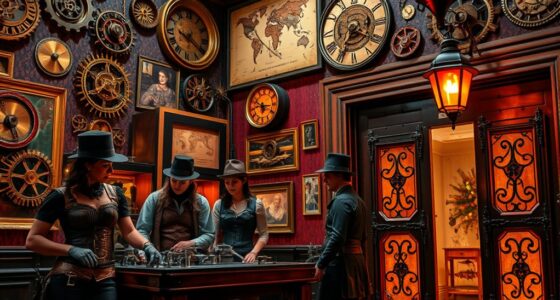In steampunk storytelling, alternate history lets you explore worlds where Victorian events and inventions took different paths. You might imagine steam-powered automata or airships shaping society differently, creating rich settings full of creative possibilities. These twists reveal how technological shifts could impact culture, politics, and daily life, giving your story depth. Exploring how history diverges helps you craft unique worlds filled with innovation and conflict—if you’re curious to see how this all unfolds, there’s much more to discover.
Key Takeaways
- Alternate history in steampunk explores worlds where key Victorian events diverged, creating unique technological and societal landscapes.
- Victorian inventions like airships and automata serve as pivotal world-building elements that reflect different technological paths.
- Divergences in history influence societal structures, sparking themes of progress, rebellion, and technological impact.
- Twisting the past challenges perceptions of progress, highlighting potential suppression or acceleration of innovations.
- These narratives deepen storytelling by blending historical divergence with imaginative inventions, enriching tone and thematic complexity.

Alternate history plays a vital role in steampunk storytelling by imagining worlds where historical events unfolded differently, creating rich, speculative settings. In these stories, Victorian inventions often serve as pivotal elements, showcasing how technological advancements could have developed differently if key moments in history had shifted. By tweaking these inventions or their origins, you can craft worlds where steam-powered automata, airships, and intricate clockwork devices are part of everyday life, reflecting a divergence from our known timeline. These Victorian inventions become more than just gadgets; they symbolize the possibilities that emerge when history takes an alternative path, fueling the imaginative landscape of steampunk. Additionally, exploring technological divergence can help develop unique societal reactions and cultural shifts within your story universe.
Alternate history fuels steampunk worlds with Victorian inventions that reflect divergent technological paths and imaginative possibilities.
Understanding how these historical divergences shape your story is essential. You might imagine a world where the Industrial Revolution happened a century earlier, leading to a society flooded with steam-powered machines and innovative transportation. Alternatively, consider a scenario where a pivotal event, like the invention of the printing press or the discovery of electricity, was delayed or advanced. These changes ripple through history, altering societal structures, political power, and technological development. Such divergences give you a playground to explore themes of progress, tradition, and rebellion, all woven into the fabric of your alternate universe.
As you develop your world, think about how Victorian society responds to these inventions and divergences. Do they accelerate societal progress, or do they create new conflicts? Perhaps steam-powered automata replace human labor in many industries, sparking debates about automation and class. Maybe airships dominate transportation, transforming trade and exploration, or clockwork devices influence warfare and espionage. These details add depth and authenticity to your setting, anchoring fantastical elements in a plausible Victorian-era context. The key is to use Victorian inventions not just as aesthetic choices but as integral parts of your story’s fabric, illustrating how different technological paths influence the culture and social dynamics.
In crafting your alternate history, you also shape the narrative’s tone and themes. Divergences in history allow you to challenge notions of progress and innovation, questioning whether technological advancement always leads to better society. You can explore what might have happened if certain inventions had been suppressed or if different scientific discoveries had taken precedence. This approach encourages you to think critically about real historical events while embracing the creative freedom that steampunk offers. Ultimately, by weaving Victorian inventions and historical divergences into your storytelling, you create a compelling, immersive world where the past is twisted to serve your narrative’s unique vision.
Frequently Asked Questions
How Does Steampunk Influence Real Historical Events?
You might wonder how steampunk influences real historical events. It often sparks historical reinterpretation by blending Victorian aesthetics with futuristic ideas, reshaping how we view the past. Through cultural symbolism, steampunk highlights themes like innovation and rebellion, which can inspire modern perspectives on history. While it doesn’t change actual events, it encourages creative dialogues about history’s possibilities, making you rethink the past’s impact on present and future innovations.
What Are the Ethical Considerations of Altering History?
Did you know that 78% of people believe altering history could have serious consequences? When you consider the ethical implications, you take on a sense of historical responsibility, weighing the moral implications of changing events. You must ask yourself if it’s right to manipulate the past, knowing it could impact the present and future. Your choices carry weight, emphasizing the importance of respecting history’s lessons and consequences.
Can Alternate History Impact Current Political Perspectives?
You might wonder if alternate history influences current political views. It does, as counterfactual analysis encourages you to reexamine events and consider different outcomes. This process can lead to political reinterpretation, shaping opinions about past decisions and their consequences. By engaging with these stories, you become more aware of how history’s twists can challenge or reinforce your perspectives, potentially impacting your political beliefs and attitudes today.
How Do Authors Balance Accuracy and Creativity?
Think of balancing accuracy and creativity like walking a tightrope—your goal is to thrill without falling. You must maintain historical authenticity to keep readers engaged, but allowing creative liberties sparks imagination. For example, authors often tweak timelines or invent gadgets, making stories vivid while respecting facts. You strike this balance by researching thoroughly and knowing when to bend history for storytelling’s sake, ensuring your tale feels both genuine and exciting.
Are There Real-World Examples of Steampunk-Inspired Technologies?
You’ll find real-world examples of steampunk-inspired technologies, like retro-futuristic gadgets and Victorian innovations, shaping modern design. Think of steampunk aesthetics influencing gadgets such as steampunk-themed watches, lamps, and fashion accessories. Some engineers even incorporate Victorian-style mechanics into contemporary devices, blending past elegance with modern tech. These innovations reflect how steampunk’s retro-futuristic vibe inspires real-world creativity, bridging history and the future in fascinating ways.
Conclusion
As you explore steampunk’s alternate histories, you realize you’re holding a time-bending key to worlds where imagination reigns supreme. Every twist and turn reshapes history like a master sculptor molding clay, making the past explode into dazzling, gear-filled wonderlands. Embracing these stories, you open a universe so rich and vibrant, it could outshine the brightest star in the sky. So, keep exploring—your adventure into this mesmerizing past is only just beginning!









